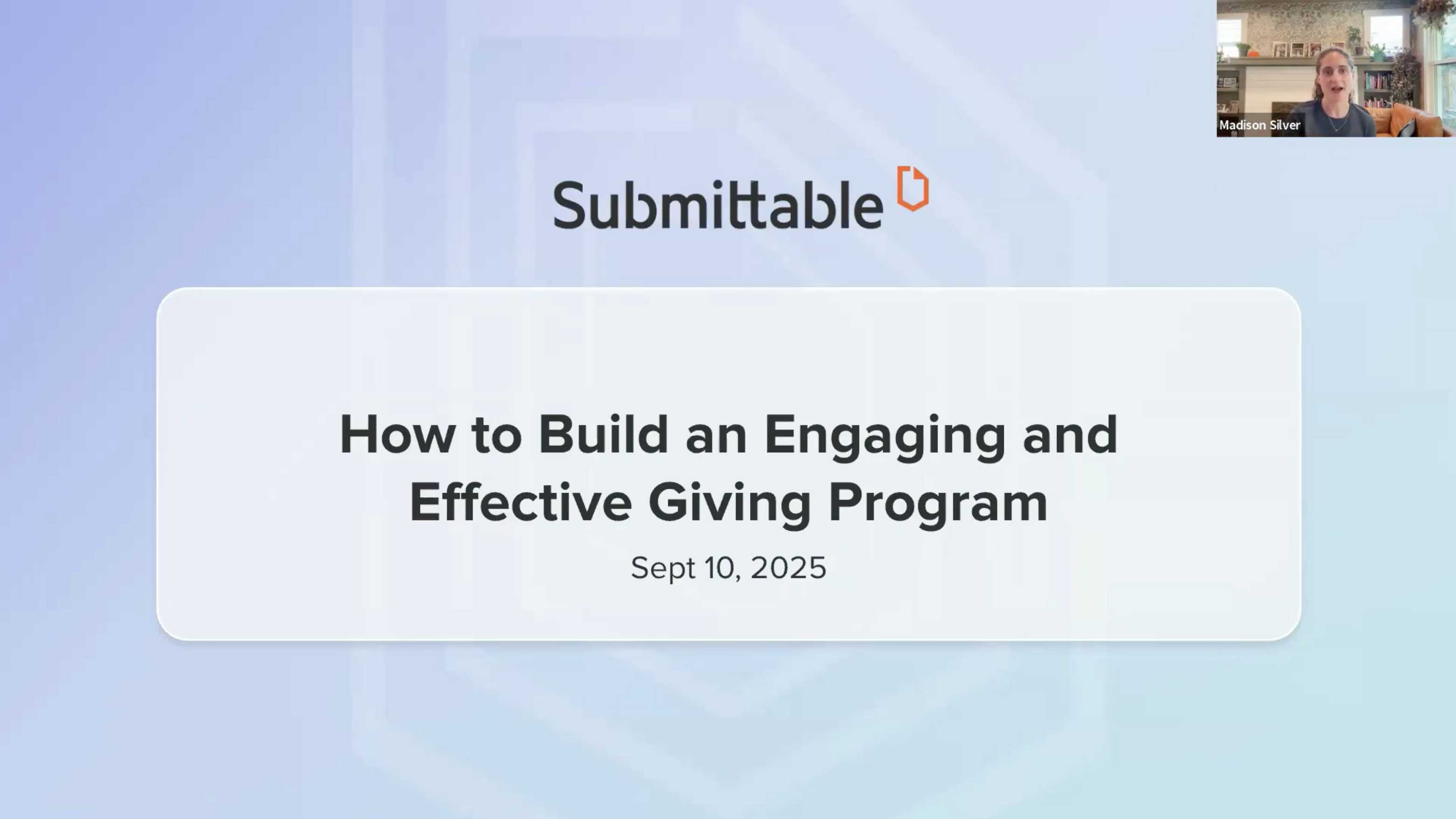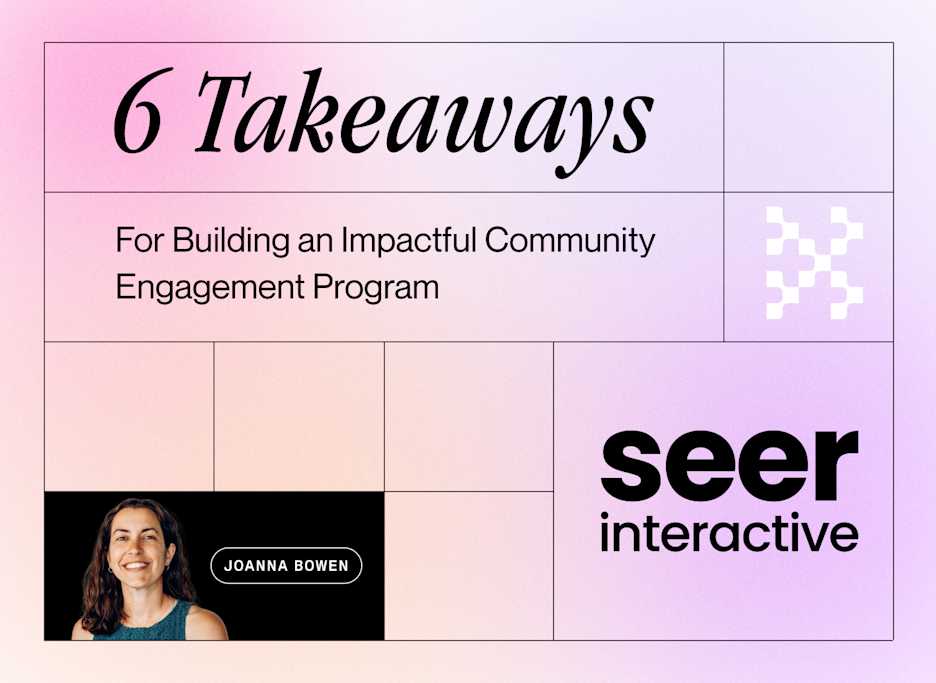CSR
The 6 keys to a strong CSR strategy [Updated for 2025]
CSR strategy must be rooted in authentic employee engagement. Here are 6 best practices to make that happen.
Seer Interactive shares 6 strategies for building impactful community engagement programs: leadership commitment, employee choice, partnerships over charity, and more.
Last Updated October 08, 2025
Seer Interactive, a B Corp marketing agency, has an ambitious goal: $15 million in community impact by 2032. They plan to achieve this through donations, volunteer hours, pro bono work, and more.
Joanna Bowen, Community Impact Lead at Seer Interactive, sat down with the Submittable team to share her strategy for reaching this ambitious goal using Bright Funds. From her successes—and a few course corrections—she identified six takeaways for building impactful community engagement programs that last.

Webinar: From Charity Work to Partnership Work with Seer Interactive
Joanna shares:
“Number one, your leadership has to be all-in. That is a non-negotiable. My job would be completely different if our leadership, not just our CEO, but our VPs, were not totally committed to this work. Our leaders often are our top volunteers. They often lead by example with donations. They hear about an organization, and they come to me, and they say, like, how can we help these folks? So they're really leading the way, and that is huge for us.
At Seer Interactive, company leadership volunteers, leads donation drives, and initiates partnerships themselves. When employees see their CEO sign up for an opportunity in Bright Funds, show up on site at volunteer events or champion unrestricted giving, it sends the important message: “This work matters at our company.”
When giving back starts at the top, employees are able to prioritize volunteering without worrying about missing a meeting.
For organizations without leadership buy-in from day one, Joanna recommends coming prepared with data and showing how programs align with business goals. According to the 6th annual CSR report from ACCP, “51% of corporate social impact professionals report being asked to tie their work more directly to business outcomes.”
Seer Interactive did exactly that. For example, when leadership’s goal was for employees to collaborate across teams and come to the office for in-person experiences, Joanna designed a volunteer event to meet both goals.
Seer Interactive has dropped the word “charity” from its vocabulary.
Joanna feels that charity implies a power imbalance. Whereas the term partnership reflects the two-way relationships Seer Interactive builds with nonprofits.
These partnerships entail showing up at events, listening to needs, and offering consistent, long-term support rather than one-off checks.
In her own words:
“We wanted to build relationships, and we wanted to collaborate together as members of the same community, whether that was with organizations in Philly, or organizations that our team members were working with in a community outside of Philly. It was also really important that our groundwork was already laid out for this shift. I just sort of had to call it out. And namely, that our CEO, Will, operates in the partnership model and not the charity model.”
Changing their language internally was a clear and outward way of making a conscious shift and showing the community that they are members of the same community, that Seer Interactive doesn’t sit outside the community that they are working with and that they want the relationships to be give and take, learning from each other.
Seer Interactive makes sure that they put employee choice at the center of their programs.
Instead of restricting giving or volunteering to a handful of corporate-selected nonprofits, employees can use Bright Funds to nominate causes for GivingTuesday donations, request sponsorships for organizations close to their hearts, direct microgrants from volunteer raffles, and volunteer at local nonprofits that matter to them.
“I think that people want to have ownership, and they want to be engaged in what's important to them in their community, and to me, that's really the goal, is people may not stay at SEER forever, but if we can help people find ways to give back, whether that's through their time or through their dollars in their community, and they can build that habit while they're with us at SEER. When they leave SEER, they're going to hopefully take that with them, and continue to engage in that way.”
Yes, Seer Interactive wants employees to volunteer because it supports its brand reputation and B-Corp status. But more importantly, Joanna’s goal is to help employees see and feel the value of volunteering, outside of just checking a box.
When employees internalize the value of volunteering, they learn to incorporate it into their lives long term and can more actively and authentically engage, increasing participation rates both at Seer Interactive as well as in the world.
Although seen as more risky by some corporations, Seer Interactive gives unrestricted grants to all their partners. Joanna believes it's important to trust the nonprofits you work with.
The organizations doing the work know what is needed to be successful, and with a background in nonprofit work, Joanna knows this first hand.
She shared that Seer Interactive is comfortable with their funds going to overhead because often what a nonprofit needs is the staff to manage the programs and they need competitive salaries to be able to attract the best people to manage the programs.
A key component of unrestricted giving is doing the work upfront to make sure that the nonprofits are ones that the company wants to support. Joanna highlights that because of the due diligence that she and team does, they are confident in giving the nonprofit the unrestricted grant. It takes more work upfront, but results in stronger partnership.
As Joanna says:
“We feel like that sometimes the most important or biggest need that nonprofits have is to keep the lights on, or it's to be able to hire the most amazing person they can in a really important role in their organization. And to do that, they need a competitive salary. And so we're okay with our funds going to those things. And we're confident in this because of the due diligence that we do up front.”
Rather than attaching strings to every donation, Seer Interactive gives organizations the flexibility to use funds where they’re needed most—whether that’s keeping the lights on, hiring staff, or launching a new program.
Joanna goes on:
“To be able to go to my development contact at an organization and just say, you know, you don't have to worry about restrictions, this is going to be an unrestricted gift, it changes the whole conversation. And again, when you've been in the building, when you've had boots on the ground, it's much easier to give those unrestricted gifts. Because you know the people that are behind the work, and you… and you have that trust.”
Early on, Seer Interactive tried a dollars-for-doers program where every volunteer hour triggered a corporate donation. The intent was great, but the logistics were overwhelming.
Employees often volunteered with grassroots organizations or informal community groups, and while Seer Interactive encouraged volunteering, they couldn’t make donations because they weren’t registered 501c3 nonprofits.
This led to frustration from employees who expected funds to be donated to the local organizations that they cared about. It also led to extra complexity on the administrative side to try to figure out alternatives.
To simplify their programs, Joanna scaled back parts and invested more heavily in programs that employees showed the most interest in, and she was able to make the money she had go further.
With Bright Funds, Seer Interactive has centralized their giving program and volunteering into one seamless platform. Employees can easily find opportunities, request funding, and track engagement—without endless spreadsheets or administrative headaches.
Additionally, Joanna has been able to reallocate budget into WeHero events, creating two company-wide events a year that brings everyone together.
According to the 6th annual CSR report from ACCP, “56% [of survey respondents] report increased pressure to measure impact, underscoring a broader shift: CSR teams must not only do good but also demonstrate clear business value in addition to community impact.”
There is a need to show the value of CSR programming, but there is also an important nuance that numbers themselves don’t tell the whole story. Often, the storytelling of a program, regardless of the exact number, matters more.
Joanna shares that Seer Interactive doesn’t get lost in counting every donation. Instead, they focus on metrics like volunteer participation rates, total giving, and outcomes reported directly by their nonprofit partners.
Joanna says that measurement looks different internally vs. externally. Internally, she is able to track and report on things like participation, dollars spent, and the number of volunteer hours using Bright Funds. She and her team set a goal for what their ideal engagement rate should be, and she can work towards it through internal programs.
Externally, Joanna takes a step back and lets her nonprofit partners tell her what the impact of their donations are.
“For our team, when we look at internally impact, we focus on participation, we focus on the dollars we spend in our budget categories, and we focus on our volunteered hours. So, for our team we measure impact around, like, we like to see about 70% of our team who spent 9 or more months in the year. At SEER, we want to see them engaged at a certain, like, number of hours. And then those activities tend to kind of drive the team donations. We use our partnerships at SEER to help us measure impact. So we let organizations tell us how our dollars and our time have impacted them. And so we try to move away from counting things like the amount of beds we donated, etc. We don't worry about things like that, because to us, that doesn't tell the whole story. We believe that our nonprofit partners are the experts in their work, because they are, and so we believe them when they tell us the impact of their gifts.”
Seer Interactive's approach to community engagement shows that successful programs take committed leadership, genuine partnerships with nonprofits, and systems that actually work for employees. Their programs are designed to last beyond individual employees' tenure.
As Joanna notes, the goal is helping people build habits around giving back that they'll carry throughout their careers, whether they stay at Seer Interactive or move on.

Webinar: From Charity Work to Partnership Work with Seer Interactive
For organizations looking to build or improve their community engagement programs, these six lessons provide a practical starting point. Start with leadership buy-in, focus on partnerships over transactions, give employees choice, keep operations simple, and measure what actually matters to your goals.
Reach out now to learn more about how Bright Funds is the best software to support your programs.

Madi is Submittable's Sr. Product Marketer focused on CSR and the Corporate audience. She helped run social impact programs during her time at Lyft and Snap! Mobile, and is now working to create the technology that those companies can use to accelerate their community impact and employee engagement work.
CSR
CSR strategy must be rooted in authentic employee engagement. Here are 6 best practices to make that happen.
CSR
When employees are the ones directing a company’s charitable efforts, they feel more valued, more inspired, and more engaged.
Announcements
A great giving program makes employees feel more connected to the places they work, the people they work with, and the things they care about.
